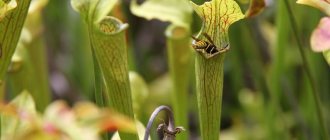Streptocarpus, or Cape primrose
There are hundreds of varieties of Streptocarpus. All of them mainly grow in the southern part of the African continent (as evidenced by the popular name of the flower - Cape primrose), as well as in Central and Eastern Africa, including Madagascar and the Comoros Islands. They were imported to Europe about 150 years ago, but the real boom began at the end of the twentieth century, when breeding work began to develop new hybrids and varieties. Currently, flower growers can choose streptocarpus with large and small flowers, painted in the most incredible shades of white, blue, lilac, yellow, burgundy; they can be fragrant and odorless, with simple flowers and with wavy petals at the edges.
In nature, streptocarpus can be found in forests, on shaded rocky slopes and in rocky cracks.
Streptocarpus is the closest relative of Gloxinia and Saintpaulia (Usambara violets). The genus belongs to the Gesneriev family, representatives of which usually grow in the wild as epiphytes or lithophytes. Cape primrose is found in wooded areas and grows in moist soil and light shade. Some species can be found on shaded rocky slopes, on the ground, in rock cracks and almost anywhere seeds can germinate.
Streptocarpus got its name due to the shape of the fruit, twisted in a spiral. Literally, the word "strepto" means "twisted" and "carpus" means fruit.
Modern hybrids only vaguely resemble natural species
Plants of the genus Streptocarpus have two main forms: multileaf and unifoliate. The first, in turn, has a rosette shape. These are perennial plants and are the ones most often grown indoors. The flowers of modern hybrids usually have a diameter of three to several centimeters and consist of five petals.
The second form has only one leaf growing from the base. Many species are monocarpic, they bloom only once, and after setting seeds they die, giving life to new plants. Although some are also perennial, that is, after the leaf dies, the flower produces a new one from the base, and the old leaf blade dies.
Monocarpics bloom once, giving life to new plants after the death of the set seeds.
Streptocarpus flowers are 2.5–3.5 cm in diameter and come in a variety of colors, ranging from white and pale pink to purple and violet, with all sorts of color combinations. The buds are tubular, in appearance they somewhat resemble a bell, they can have smooth or wavy edges, simple or double, decorated with cloves or scallops. Large leaves have an elongated shape and a velvety surface. The fruits are pods with small seeds.
“In captivity” Streptocarpus grows well, blooms and sets seeds. If you create suitable conditions for the flower, it will bloom for quite a long time and very profusely, as flower growers say - “with a cap”. Reproduction of the plant at home is also not difficult; streptocarpus can be grown from seeds, leaves, and even from small fragments of the leaf blade.
Natural species of streptocarpus
Currently, botanists have identified more than 130 species of streptocarpus. Some of the most popular are:
- Streptocarpus rexii (S. rexii). The plant is stemless, its distinctive feature is long pubescent leaves, the length of which reaches 25 cm. The flowers of the royal streptocarpus are colored purple, and there are purple streaks inside the throat.
- Streptocarpus stem (S. caulescens). A plant whose stem grows up to 50 cm in height. Its downward-sloping flowers have a soft blue tint.
- Kirk's Streptocarpus (S. kirkii). The leaves and flower stalks of the ampelous plant reach 15 cm and have a drooping shape. The buds of a light purple hue are collected in umbrella inflorescences.
- Streptocarpus Wendlandii (S. wendlandii). The flower has one large oval-shaped leaf, the length of which reaches 0.9–1 m. The wrinkled and pubescent leaf blade is colored green on top, and reddish-purple below. Flowers with a diameter of 5 cm bloom from the axils of a long peduncle. Streptocarpus Vendlana reproduces exclusively by seed; after flowering it dies.
- Streptocarpus rocky (S. saxorum). The plant is perennial. Its distinguishing feature is its woody base. The leaf blades are small and oval in shape. The shoots are twisted at the ends. Small lilac flowers bloom in spring and summer.
- Streptocarpus primulifolius (S. primulifolius). The plant belongs to the rosette species. The stem grows up to 25 cm in height, up to 4 flowers bloom on it, the petals of which are decorated with all kinds of dots, streaks and strokes.
- Streptocarpus johannis (S. johannis). Rosette type with straight stem. The leaves grow up to 50 cm in length and their width is 10 cm. About 30 lilac-blue flowers bloom on the peduncle.
- Streptocarpus major (S. grandis). A single-leaf species, its single leaf blade is quite large, growing up to 40 cm in length and 30 cm in width. The stem rises 0.5 m; flowers of a light purple hue with a darker throat and a white lower lip bloom at its top.
- Streptocarpus cornflower (S. cyaneus). The stems of the rosette plant reach 15 cm. The flowers are painted in different shades of pink and grow two per stem, the middle of the bud is painted yellow, the pharynx is decorated with different dots and stripes of purple color.
- Streptocarpus white (S. candidus). The leaf blades of the rosette plant grow up to 45 cm in length and reach 15 cm in width; the texture of the leaf surface is wrinkled and velvety to the touch. The snow-white flowers are decorated with yellow stripes, the throat is decorated with purple dots, and the lower lip is decorated with red strokes.
- Streptocarpus glandulosissimus (S. glandulosissimus). The stem of a plant of this species grows up to 15 cm in length. The buds are painted in different shades from purple to dark blue.
- Streptocarpus primrose (S. polyanthus). The plant is a single-leaved variety. The leaf blade is densely pubescent and grows up to 30 cm in length. The flowers, about 4 cm in size, are painted in various shades of blue with a yellow spot in the middle.
- Streptocarpus Holst (S. holstii). The flower has fleshy stems, the size of which reaches 50 cm. The leaf blades have a wrinkled texture, they reach 5 cm in length. The buds are painted purple, and their base is snow-white.
Photo gallery: Streptocarpus species
The flowers of the royal streptocarpus are purple in color, with purple streaks on the throat
Streptocarpus Wendlana reproduces exclusively by seed
Small lilac flowers of Streptocarpus rocky bloom in spring and summer
The petals of Streptocarpus primulolifolia flowers are decorated with all sorts of strokes and dots
About 30 lilac-blue flowers bloom on the peduncle of Streptocarpus johanensis
The stem of Streptocarpus major rises 0.5 m; flowers of a light purple hue with a darker throat bloom at its top
Streptocarpus stem flowers have a soft blue hue.
Streptocarpus Kirka is grown as a hanging plant.
Collection varieties and hybrids of streptocarpus
Currently, breeders are doing a lot of work to create spectacular hybrids and varieties of streptocarpus. More than a thousand varieties of domestic and foreign selection are known; it is, of course, impossible to describe all of them in one article; we will present only a few of them.
- Streptocarpus with flowers of rich dark purple shades with a velvety surface of the petals - varieties Dracula's Shadow, Thunderous Overture.
- Flowers with a fantasy pattern of strokes of different shades on plants of the Himera Pedro and Tarjar's Roger varieties.
- Flowers with the finest mesh (“vein pattern”) look incredibly impressive. Among the varieties whose buds have a similar color include Victorian Lace, Maja, Lisica, and Spring Dreams.
- DS-Kaya's Heart is a variety whose flowers have a matte white underside.
- DS-Meteor Shower - with blue-white upper petals and a yellowish-blue border around the edge.
Varietal diversity of streptocarpus in the photo
The Dracula's Shadow variety has magnificent flowers with velvety petals
Thunderstorm Overture - an excellent variety of domestic selection
The Himera Pedro variety has delicate flowers of different shades of lilac
Streptocarpus Tarjar's Roger has very showy flowers
Streptocarpus Victorian Lace flowers look like bright lace
Petals of Streptocarpus variety Maja are decorated with purple streaks
Lisica variety has wavy edges of petals
Spring Dreams - a variety of streptocarpus with incredibly delicate flowers
The petals of flowers of the DS-Kaya Heart variety are decorated with a mesh of dark veins
DS-Meteor Shower with small, bright colors and dark rays from the throat
Guest from the tropics
Streptocarpus (lat. Streptocarpus) belongs to the Gesneriaceae family , in which there are about one hundred and thirty species. The flower's homeland is subtropical and tropical forests located on the slopes of the mountains of Thailand, Madagascar and South Africa. Some species love arid areas, while others, on the contrary, prefer to hide in a shady forest. Streptocarpus can be either annual or perennial, herbaceous or shrubby.
The leaves of the plant are slightly wrinkled and pubescent, reaching a length of 30 cm with a width of 5-7 cm. The color of the leaves can be either green or variegated in the bred varieties. The flowers are located on tall peduncles that emerge from the leaf axils. They have the shape of a bell with elongated lower petals of a variety of colors: red, pink, purple, white, lavender, blue, two or three colors.
The fruit of Streptocarpus is a twisted pod, which is how the plant got its name, because it is translated from ancient Greek as “twisted fruit.” It contains the seeds of the flower.
Today, this flower is rapidly gaining its place among indoor plants, and plant lovers try to carefully follow the rules of maintenance and care when growing, but, unfortunately, streptocarpus can be damaged by disease or pest .
Table: requirements for growing streptocarpus at home
| Season | Temperature | Humidity | Lighting |
| Spring Summer | +23–27 °C. Plants tolerate drafts well, but do not like heat. | Requires high humidity. This requires regular spraying with water at room temperature. However, it should be noted that water should not get on the leaves and flowers of the plant. Spray the air around the flower and install a humidifier nearby. In the summer you can arrange a shower (the flower responds well to the procedure), but you cannot immediately put it on the windowsill; first you need to dry the plant in the shade. | The lighting is diffuse. It is better to place it on the windowsill of a window facing East or West. In summer you can take it out onto the balcony or loggia, but shade the flower from direct sunlight. |
| Autumn winter | +18 °C. | Spraying once a week. If streptocarpus blooms, then droplets should be avoided on the flowers. | Requires additional illumination with a fluorescent lamp. |
Campanula is also distinguished by its unpretentiousness and abundant flowering. You can learn more about this flower from the material:
Lighting and temperature
Plants respond normally to both artificial lighting and sunlight. But do not expose them to excessive exposure to direct sunlight.
When placing Streptocarpus hybrid on a windowsill, additional lighting during shortening daylight hours in winter and autumn will help extend the flowering time of the plant.
With the help of artificial lighting (the best option is phytolamps with a uniform light flux), you can achieve flowering of streptocaptus all year round.
The temperature regime for Streptocarpus hybrid should be maintained at +24+26 °C. In winter, the temperature may drop slightly to +20 °C. It is important to maintain stable heat in the room. Sudden changes between cold and warm air negatively affect the health of the plant.
Caring for the "Cape primrose"
Streptocarpus is considered a non-capricious plant. All he needs is regular hydration and feeding.
Recent Entries
Lilac perennials that are beautiful, compact and do not crowd out other plants Why when buying seedlings you should not take the sellers’ word for it and how to determine the age of the plant using 3 signs Tomato seedlings have turned purple or whitish: why the color has changed and how to save the plants
Watering
Watering the plant should be done regularly. Please note that the flower does not tolerate excessive moisture and overdrying of the soil very well. The water for irrigation is pre-settled for 24 hours and watered along the edge of the pot. An hour after the procedure, it is recommended to drain excess moisture from the pan.
Optimal soil moisture can be determined by performing a simple test. Blot the surface of the peat substrate with a paper napkin. If there are small spots of moisture on it, then the substrate is sufficiently moistened. If the surface of the soil in the pot is shiny and has a black tint, then such soil is too wet for streptocarpus, and the red color of the peat indicates the need for watering.
Feeding streptocarpus
Fertilizers should be applied every one and a half to two weeks, using liquid preparations for flowering plants. This will significantly increase the growth of streptocarpus, accelerate the appearance of buds and strengthen the flower’s immunity, which will help protect it from pests and diseases.
Kemira Lux and Etisso fertilizers are excellent for feeding. The only condition is that the solution should be diluted in a concentration two times less than indicated in the instructions.
Flowering and dormant period
As a rule, streptocarpus bloom in late April - early May. During this period, they need good lighting, but they must still be shaded from direct sunlight, otherwise the leaves may wither or get burned. It is recommended to systematically remove wilted flowers and peduncles; this will stimulate the appearance of new peduncles.
To ensure abundant flowering, you need to remove faded flowers and peduncles.
Streptocarpus does not have a rest period as such. But in winter, in order for the plant to gain strength before flowering again, it needs special conditions. At this time, the flower is kept at a temperature of +18 ° C and the amount of watering is reduced.
To stimulate flowering, the plant must be replanted in the spring into a fresh substrate, adding horse compost to it. Old and long leaves need to be shortened to 4–5 cm, which will stimulate the appearance of new leaf blades. Once the flower has developed a good amount of green mass, it will be ready to bloom. Please note that in order to get more abundant and long-lasting flowering, it is recommended to break off the first peduncle.
Table: problems when growing streptocarpus
| What does the plant look like? | What is the reason? | How to fix the situation? |
| Streptocarpus leaves yawned. | Lack of moisture | Water the flower. |
| The leaves have turned yellow. | Nutrient deficiencies | Feed streptocarpus with complex fertilizer. |
| The tips of the leaves are dry. |
| Spray the air around the flower, being careful not to let drops of water fall on the leaves. Plant the streptocarpus by dividing the rosette into several parts. |
| A rusty coating appeared on the leaves. |
|
|
If a plant does not bloom with good care, then the reason lies in the aging of the foliage. Each leaf can produce no more than 10 peduncles.
Reproduction of streptocarpus
Streptocarpus propagates in three ways: by dividing the bush, cuttings and sowing seeds. With the first two methods, the plants obtained as a result of propagation will be an exact copy of the parents, but when sowing seeds, surprises are possible.
The division of the streptocarpus bush is carried out during transplantation of an adult plant. At the same time, young rosettes are separated from the mother plant and planted in separate pots. How to do this correctly was described above.
Cuttings
For cuttings, take a young healthy streptocarpus leaf and cut it across so that you get pieces 4-5 cm long. You can make cuts along the central vein and get two parts of the leaf. The resulting segments are kept in the air for half an hour to ventilate the sections and planted vertically in prepared pots.
You can prepare the soil mixture for streptocarpus cuttings yourself by taking peat, vermiculite and coconut substrate in equal parts. The soil for rooting should be light and moist. The leaf fragments are lightly squeezed and the pots are put into the greenhouse.
Ideal conditions for rooting streptocarpus are high humidity, air temperature from +22°C to +25°C and lighting for 12 hours. The greenhouse must be ventilated every day, removing accumulated condensation from the walls. During the first month, roots form on the cuttings, and after another 2-3 weeks, young leaves will appear.
From this moment on, the greenhouse should be slightly open so that the leaves do not rot from high humidity. After the appearance of the second leaf, young streptocarpus can be planted in separate pots.
Propagation by seeds
Streptocarpus is easily propagated by seeds, but the result may be plants that are not similar to their parents - hybrids. It often happens that hybrids surpass their parents in beauty, so enthusiastic Michurinites love this method of reproduction.
To obtain streptocarpus seeds at home, flower growers resort to self-pollination, because in indoor conditions there is no wind or pollinating insects. To do this, pollen from a flowering plant is shaken onto flowers of other varieties. As a result of pollination, seed pods will appear, which, when ripe, burst and the seeds scatter in different directions.
To collect the seeds, the streptocarpus capsules are cut off before they are completely ready and wrapped in a paper or cloth napkin. In a warm, bright place, the boxes will ripen and open, and the seeds will end up in the napkin.
For seed germination, the length of daylight is very important, therefore, depending on the time of year, if there is not enough natural light, additional lighting will be needed.
A flat container is filled with a light, damp substrate and streptocarpus seeds are laid out on the surface. They will germinate in the light, so there is no need to cover them with soil. The container is covered with glass or plastic film and placed in a warm, bright place. The temperature for germination should be at least +23…+25оС. The film or glass is removed every day for 10-15 minutes, and the accumulated condensation is removed. Daily ventilation will help prevent mold from growing.
In two to three weeks, streptocarpus shoots will appear, and the glass or film can be removed. After the second leaf appears, the plants can be planted in separate cups. It is very important that the pots should be small and grow gradually. As the flower grows, so does the pot.
Streptocarpus belongs to the same family as Saintpauliaceae - Gesnerieceae. © Green Fuse Botanicals
Table: flower protection from diseases and pests
| Disease/pest | Signs | Methods of disposal |
| Gray fungal rot | Fluffy grayish mold on the leaves, caused by the botrytis fungus, appears when there is excessive dampness and when kept in cool conditions. |
|
| Powdery mildew | Whitish coating on leaves, flowers and stems. |
|
| Aphid |
| Treat with an insecticide (Fitoverm, Akarin, Actellik). Carry out 2-3 treatments (according to instructions). |
| Weevil |
|
|
Photo gallery: diseases and pests affecting streptocarpus
A white coating on the plant indicates the appearance of powdery mildew.
When kept cool and too moisturized, the flower is affected by gray rot
The weevil gnaws leaves, causing damage to the plant
When infested by aphids, the leaves curl and become deformed.
Soil and fertilizers
The soil for Streptocarpus hybrid should be light, permeable, slightly acidic, rich in organic matter. Small pots are suitable for young plants, a little larger for adults, but a container diameter of up to 14 cm is optimal. At the bottom of the pot you need to make good drainage from medium-sized expanded clay or other suitable materials.
If the soil is not very rich in nutrients , it is recommended to increase the content of nitrogen, phosphorus, potassium and trace elements. To grow plants, you can use loose earthen soil mixtures, adding vermiculite, agroperlite and chopped sphagnum moss.
Up to 10 peduncles can form from any leaf of Streptocarpus hybridus Since streptocarpus are characterized by year-round flowering and rapid growth, the soil is often depleted and fertilizing is necessary.
Only healthy plants can be fed Mineral complexes in which nitrogen, phosphorus, and potassium are in a ratio of 6:3:6 with basic microelements are suitable for fertilizer. During flowering, you can feed the flower with fertilizers with a large amount of phosphorus and potassium and less nitrogen.
Reviews from flower growers
I only recently, this summer, started growing streptocarpus. I bought leaves and now little babies are growing out of them. I bought some plants as small children. Some stand and bloom on the loggia - they like the cool. Some are under the lamps on the window (the window is also always open to the loggia .The main thing is not to overwater, otherwise they are very unpretentious! If they grow to flowering, they bloom constantly.
Deer https://forum.bestflowers.ru/t/streptokarpus-uxod-v-domashnix-uslovijax.109530/
Streps are beautiful, I fell in love with them at first sight, but when it came to the reproduction of existing children, I had to suffer.
But this probably makes me love them even more now)) For me it was problematic. In general, there are 3 options: propagation by seeds, dividing the bush and growing children from leaves. Nat31 https://irecommend.ru/content/zagadochnyi-tsvetok-streptokarpus-ukhod-i-razmnozhenie-strepsov-mnogo-mnogo-foto-moikh-lyubi
So I wouldn’t say that their flower is problem-free.
He is more demanding than many others. Well, watering is not difficult, it’s better to dry it out a little between waterings. Categorically does not like water getting on the leaves. Loves humid air, but, again, not too much. I'm not very painless with transplants. Transplanted plants take a long time to recover and get sick. Almost always, regardless of whether I divided the bush or replanted it entirely. Here you need to feel them. None of my other pets had such problems with transplantation (oh, no, there is also a silver peperomia, which is also very sensitive to transplantation - but with the rest everything is always ok) But even on a north window you can achieve flowering, and then it turns out so cheerful clearing: Natlli https://wap.romasha.forum24.ru/?1–18–0-00000011–000–0-0–1274589440
I grew my own streps from seeds.
(NK it seems, if necessary, I’ll look more precisely later). They germinate well and fairly quickly, but the seedlings are very small and weak and grow slowly. They categorically refuse to live without a greenhouse. They were finally removed from the greenhouse only 6–8 months after sowing. Picking noticeably accelerates the growth of young plants. They bloomed for me about a year and a half to two years after sowing. I also propagated them using cuttings using an “unconventional” method - I simply left them in a damp, hermetically sealed bag. Natali https://homeflowers.ru/yabbse/index.php?showtopic=3173
Rooting a leaf
Rooting of leaf fragments occurs in about two weeks . The appearance of babies at the leaf veins can be noticed after 1.5–2 months. One or two babies are formed on each vein. After the children grow to at least 2 cm, they can be transplanted into a separate container.
One hundred gram disposable cups can be used as dishes for transplanting children. It is also better to keep children in a greenhouse, gradually accustoming them to room conditions through ventilation. Separating the babies from the leaf causes some difficulties, because their “thin” legs are very fragile and can be easily damaged. All children must be treated with root and planted without deepening the root collar.
Video: charming varieties of streptocarpus
Modern streptocarpus hybrids are real works of art. The color range of the new varieties is impressive: purple, snow-white, pink, dark blue, lilac, lavender and almost black flowers, decorated with streaks, dots, streaks and a mesh of veins. This plant will certainly decorate any home.
- Author: Olga Isakina
I am interested in many things. Handicrafts, gardening, floriculture and cooking are just a few of my hobbies. I am constantly discovering something new and learning something interesting. I am ready to share all my knowledge with my readers. Rate this article:
- 5
- 4
- 3
- 2
- 1
(5 votes, average: 3.8 out of 5)
Share with your friends!
Problems during cultivation
Frequently encountered problems when growing Streptocarpus and their elimination:
| Problem | Causes | Solution |
| Drying leaves | Failure to comply with temperature conditions | Avoid dropping below +20°C in summer and +15..18°C in winter |
| Drying leaf tips | Low air humidity | Spray the surrounding air more often, place a container of water next to the flowerpot |
| Lack of growth | Nutrient deficiency, improper pot size | During the growing season, apply complex fertilizers once every 1-1.5 weeks, transplant into a new container of a suitable size. |
| Wilting leaves | Rare watering | Do not allow the soil to dry out completely |











